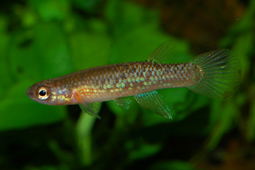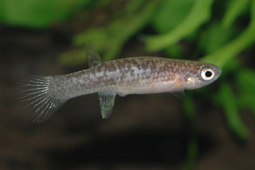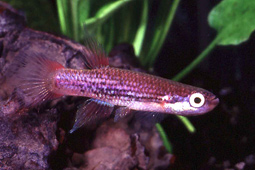History
Alternative name Laimosemion torrenticola.
Rivulus torrenticola was first discovered by Mr. Patrick de Rham, on October 13. 1976. De Rham donated two small specimen to ZMA in Amsterdam, The Netherlands. Rediscovery followed by Frans Vermeulen, intiator of this site, and his wife A.C.M. Vermeulen - Vervenne during their expedition to Guyana January 25. 1992.
The given name refers to the habitat the species was found. They live solely in small creeks running down from the mountains. (from Latin: torrens, torrentis = a torrent or fast flowing creek) and (from Latin: cola = inhabiting, dweller).
The species is closely related to Rivulus gransabanae and assumed to Rivulus lyricauda and Rivulus breviceps as well. It can be found in the same creek with Rivulus (Oditichthys) immaculatus but both species prefer different parts of the stream. R. immaculatus lives in the swampy parts at the plateau and Rivulus torrenticola more at the steep parts that become quick running torrents during rainfall. Only in one occasion one single R. immaculatus was found together with the R. torrenticola in the same part of the steep creek.
Reproduction
Keeping and breeding is not easy and a good cover of the aquarium is necessary because there ability to jump, even true the smallest opening, is unbelievable.
This species can, if there is enough space for them, housed in a tank with more males than one only and several females. If separated before and brought together again however, they can be very agressive to each other and fight to become dominant to others. The best way to have much offspring is to put a pair or an trio in a small tank from 10 liters with a small filter in it or with some airation. On the bottom some peat moss or dark gravel and a floating "mop" to give space for laying there eggs. The fish will, if they become a rich varity of life food, spawn during there whole adult life and produce daily between 5 to 15 eggs.
The eggs should be collected by hand and stored for about 14 days in a small container. Eggs are 1.8 mm and amber colored. It is wise, to add some acryflavine to the water you store the eggs in, to provent fungus coming up.
After hatching the young fry can eat fresh artemia nauplii without any problem. It takes 5 to 6 months to raise them to maturity. Often the number of males is far above the number of females. For some species this can become a major problem for the breeder as many young fishes must be raised to distribute a few pairs to other hobbyists. Recent personal tests laerned that lower pH levels during the time of hatching gave a higher percentage of females.
To achieve this I use some peat moss that I add to the container with the egss just before they are ready to hatch. This peat moss also is a good way to prevent eggs to become attact by fungusses. There lifespan can be up to 3 years in captivity.
Remarks :
In the mountain area of the Guyana Shield in early morning between 05.00 and 09.00 hours rain falls down for a few hours almost every day. Shortly after the rain stops, these small creeks show no, or almost no current and the species can be found in the hiding places from the many logs that falled down into the creek. During rainfall current get swift and turbulent and the fishes seek shelter in the shallow parts between the logs or even jump out of the water to avoid washed down. The main river is full of predators that make it almost impossible for Rivulus torrenticola to change the creek they live in. By this natural barricade it is possible the variation in color can become remarkable from one creek to the other, even if these creeks are not far from each other.
The air temperatures in the mountains can get rather cool and the species should be kept cool also. Best temperature for breeding and keeping is about 20 - 22 C.
Eggs are very large for a small fish like this. So productivity is very low. In their natural habitat no predaters are present so they do not need to produce lots of offspring also.
Variations
Map
Meristics
Max. size 4.0 cm.
Dorsal 7.9,
Anal 10.8,
D/A 6.0,
LL scale count (average) 31.4
Pre- dorsal length to % SL – 68.8 %
Depth to % SL – 23.6 %
Literature



